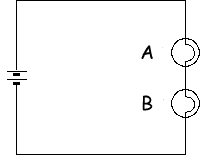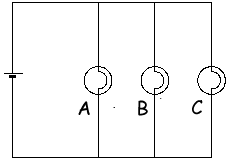Questions on Electric Circuits
Q10. In the circuit above, both the bulbs light up. Suddenly they both go out. The two bulbs are tested. Bulb A works but bulb B is broken.

(a) Bulb A was not broken but it went out. Why did it go out?
Bulbs A and B are in series. The break in the filament of bulb B serves as a break in the circuit. You need a complete conducting loop for a current to flow. The break means than no current flows so the lamp A goes out too. 
1 mark
In the circuit below, only bulb B is broken.

(b)
(i) Does bulb A light up? Yes 
1 mark
(ii) Does bulb C light up? Yes 
1 mark
Maximum 3 marks








